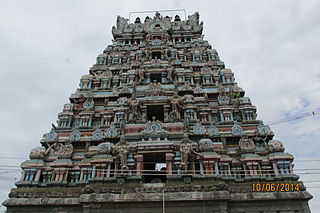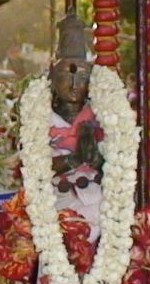
Aditya I, the son of Vijayalaya, was the Chola king who extended the Chola dominions by the conquest of the Pallavas and occupied the Western Ganga Kingdom.

Thiruvarur also spelt as Tiruvarur is a town and municipality in the Indian state of Tamil Nadu. It is the administrative headquarters of Tiruvarur district and Tiruvarur taluk. The town was one of the five traditional capitals of the Chola empire, with one of the emperors of the dynasty, Kulothunga Chola I, having it as his capital. The town is believed to be of significant antiquity and has been ruled, at different times, by the Medieval Cholas, Later Cholas, Later Pandyas, Vijayanagar Empire, Marathas and the British. The town is known for the Thyagaraja temple, and the annual chariot festival held in the month of April.

Darasuram or Dharasuram is a neighborhood of Kumbakonam Municipal corporation in Thanjavur District, Tamil Nadu, India. According to the 2001 census, the town had a population of 13,027. The town is known for the Airavateswara temple constructed by the Rajaraja Chola II in the 12th century CE. The temple is a recognised UNESCO World Heritage monument.

Kulothunga Chola III also known as a Chakravarti was the ruler of the Chola empire from 1178 to 1218 CE, after succeeding Rajadhiraja Chola II. Kulothunga Chola III gained success in war against his traditional foes. He gained victories in war against the Hoysalas, Pandyas of Madurai, Cheras of Venad, the Sinhalese kings of Polonnaruwa, as well as the Chodas of Velanadu and Nellore. He also restored Chola control over Karur, which were ruled by the Adigaman chiefs as vassals of the Cholas. He drove out the Hoysalas under Veera Ballala II who had made inroads in the Gangavadi and adjoining areas of Tagadur in Kongu country in an effort expand their territory. However, during the last two years of his reign, he lost in war to the resurgent Pandyas, heralded a period of steady decline and ultimately, demise of the Cholas by 1280 CE. Kulottunga III had alliances with the Hoysalas. The Hoysala king Veera Ballala married a Chola queen called Cholamahadevi and gave his daughter Somaladevi in marriage to Kulottunga III.

Thyagaraja Temple is a Shiva temple, located in the town of Thiruvarur in Tamil Nadu, India. Shiva is worshiped as Puttridankondar, and is represented by the lingam. Daily poojas are offered to his idol referred to as Maragatha lingam. The main idol of worship is Lord Veedhi Vidangar (Thiyagarajar), depicted as a Somaskanda form .His consort Parvathi is depicted as Kondi. The presiding deity is revered in the 7th century Saiva canonical work, the Tevaram, written in Tamil by saint poets known as the nayanars and classified as Paadal Petra Sthalam.

Mahalingeswaraswamy Temple, Thiruvidaimarudur is a Hindu temple dedicated to the deity Shiva, located in Tiruvidaimaruthur, a village in the South Indian state of Tamil Nadu. It is significant to the Hindu sect of Saivism as one of the seven major Shiva temples. Shiva is worshiped as Mahalingeswaraswamy, and is represented by the lingam, with his idol referred to as Jothimayalingam. His consort Mookambika is depicted as Pirguchuntarakujambigai. The lingam of the temple is believed to be the focal point for the seven consorts of Shiva. The presiding deity is revered in the 7th century Tamil Saiva canonical work, the Tevaram, written by Tamil poet saints known as the nayanars and classified as Paadal Petra Sthalam. The 9th century Saiva saint poet Manikkavacakar has sung praise about the temple in his works.

Aiyarappar temple is a Hindu temple dedicated to Shiva located in the village of Tiruvaiyaru, Tamil Nadu, India. The Five Rivers are Vadavaru, Vennaaru, Vettaaru, Kudamuruttiyaaru and Kaaviriyaaru. Shiva is worshiped as Aiyarappar, and is represented by the lingam and his consort Parvati is depicted as Dharmasamvardhini. The presiding deity is revered in the 7th century Tamil Saiva canonical work, the Tevaram, written by Tamil poet saints known as the nayanars and classified as Paadal Petra Sthalam.

Brahmapureeswarar Temple or Thiurkolili is a Hindu temple dedicated to Shiva located in Thirukkuvalai in Nagapattinam district of Tamil Nadu, India. Shiva is worshiped as Brahmapureeswarar, and is represented by the lingam and his consort Parvati is depicted as Vandamar Poonguzhali. The presiding deity is revered in the 7th century Tamil Saiva canonical work, the Tevaram, written by Tamil poet saints known as the nayanars and classified as Paadal Petra Sthalam.

The Three Crowned rulers, or the Three Glorified by Heaven, or World of the Three or The Tamil Kings, primarily known as Moovendhar, refers to the triumvirate of Chera, Chola and Pandya who dominated the politics of the ancient Tamil country, Tamilakam, from their three Nadu (countries) of Chola Nadu, Pandya Nadu and Chera Nadu in southern India. They signalled a time of integration and political identity for the Tamil people. They would frequently wage war against one another under a period of instability until the Imperial period of Rajaraja I who united Tamilakam under one leadership.

Airavateswarar Temple is a Hindu temple located at Maruthuvakudi near Aduthurai in the Thanjavur district of Tamil Nadu, India.

Nami Nandi Adigal, also spelt as Naminandi adigal, Naminandi adikal and Naminanti Atikal, and also known as Naminandi and Naminandhi, is a Nayanar saint, venerated in the Hindu sect of Shaivism. He is generally counted as the 27th in the list of 63 Nayanars.

Isaignaniyar, also spelt as Isainaniyar, Isaignaniyaar, Isaignaniar and Isaijnaniyar and also known as Isai-jnani Ammaiyar, is the mother of Sundarar, one of the most prominent Nayanar saints. She is herself regarded as a Nayanar saint, venerated in the Hindu sect of Shaivism, along with her husband Sadaiya Nayanar. She is generally counted as the last in the list of 63 Nayanars.
Viralminda Nayanar, also known as Viranmindar (Viranmintar), Viranmintan and Viranminda Nayanar, is a Nayanar saint, venerated in the Hindu sect of Shaivism. He is generally counted as the sixth in the list of 63 Nayanars. He was a contemporary of Sundarar. He along with Cheraman Perumal Nayanar are the two Nayanars from Kerala. Viralminda Nayanar is described in legends as the reason Sundarar composed a hymn to the Nayanar saints, which became the first compilation of the list.
Eyarkon Kalikkama Nayanar, also known as Eyarkon Kalikama Nayanar, Kalikkama Nayanar, Kalikamba Nayanar, Kalikkamar, Kalikamar, Kalikkambar, Yeyarkon Kalikkamar and Eyarkon Kalikkamar, is a Nayanar saint, venerated in the Hindu sect of Shaivism. He is generally counted as the 29th in the list of 63 Nayanars.

Seruthunai Nayanar, also known as Seruthunai, Seruthunaiyar and Seruttunai Nayanar, was a Nayanar saint, venerated in the Hindu sect of Shaivism. He is generally counted as the 55th in the list of 63 Nayanars.

Kutruva Nayanar, also known as Kootruva , Kutruva, Kutruvar, Kootruvar, Kurruva Nayanar, Kurruvar, Kurruvan, Kutruvanar, Kurrrruvar, Kalappallan and Kalappalar, was a chieftain of Kalandai and a Nayanar saint, venerated in the Hindu sect of Shaivism. He is generally counted as the 39th in the list of 63 Nayanars. Kutruva is often described as a Jain, who became a devotee of Shiva, the patron god of Shaivism.

Kalarsinga Nayanar, also known as Kalarsinga, Kazharsinga, Kalarcinkan, Kalarsingan, Kalarsinganar, Kalarsingar, Kalarcingar and Kalar-chingar (Kalar-singar), was a Nayanar saint, venerated in the Hindu sect of Shaivism. He is generally counted as the fifty-fifth in the list of 63 Nayanars. While his identity remains a matter of debate, many scholars identity Kalarsinga Nayanar as the Pallava king Narasimhavarman II (Rajasimha), who reigned between 700 and 728 CE.

Tiru Nilakanta Yazhpanar was a Nayanar saint, venerated in the Hindu sect of Shaivism. He is generally counted as the sixty-first in the list of 63 Nayanars. While the first part of his name can be spelt as Tirunilakanta, Tirunilakantha, Tiru Neelakanta, Tiru Nilakanta, Nilakantan and Thiruneelakanda, Yazhpanar is spelt as variously as Yalppanar, Yalapannar, Yalpanar and Yazhpaanar. He is described as a companion of Sambandar, one of the most prominent Nayanars.

Cheraman Perumal Nayanar, one of the sixty-three Nayanars, was a bhakti poet-musician and religious teacher from medieval south India. Historians tentatively identify the Perumal with Rajasekhara, the 9th century ruler of the Chera Perumal kingdom of Kerala.
Srimoolanathar Temple is a Hindu temple dedicated to the deity Shiva, located at Keezhaiththanjavur in Nagapattinam district, Tamil Nadu, India.












